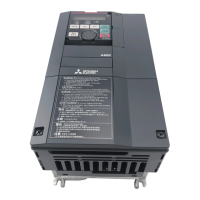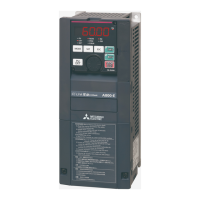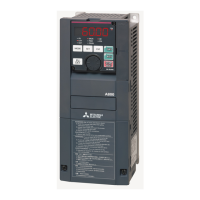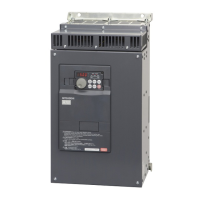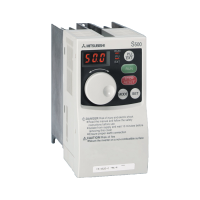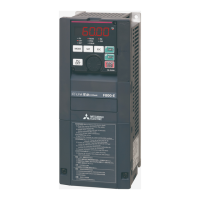OPTIONS
216
3) Addition of Pr. 502 "error-time stop mode selection"
You can select the inverter operation if a communication line fault or a fault of the CC-Link plug-in option itself
occurs.
Parameter Number Setting Range
Minimum Setting
Increments
Factory Setting
502 0, 1, 2 1 0
(About setting)
At Fault Occurrence
Error Recognition after Elapse of
Pr. 500 Time
At Fault Removal
Fault
Pr. 502
Setting
Operation Indication
Alarm
output
Operation Indication
Alarm
output
Operation Indication
Alarm
output
0 Continued None
Not
provided
Coast to
stop
E.OP3 lit Provided
Kept
stopped
E.OP3 kept
lit
Kept
active
1 Continued None
Not
provided
Decelerated
to stop
E.OP3 lit
after stop
Provided
after stop
Kept
stopped
E.OP3 kept
lit
Kept
active
Communication line
2 Continued None
Not
provided
Decelerated
to stop
E.OP3 lit
after stop
Not
provided
Restart
Normal
indication
Not
active
0
Coast to
stop
E. 3 lit Provided
Coast to
stop
E. 3 lit Provided
Kept
stopped
E. 3
kept lit
Kept
active
1
Decelerated
to stop
E. 3 lit after
stop
Provided
after stop
Decelerated
to stop
E. 3 lit
after stop
Provided
after stop
Kept
stopped
E. 3
kept lit
Kept
active
Plug-in option itself
2
Decelerated
to stop
E. 3 lit after
stop
Provided
after stop
Decelerated
to stop
E. 3 lit
after stop
Provided
after stop
Kept
stopped
E. 3
kept lit
Kept
active
Note: 1. A communication line fault [E.OP3 (alarm data: HA3)] is a fault that occurs on the
communication line, and a fault of the CC-Link plug-in option itself [E. 3 (alarm data:
HF3)] is a communication circuit fault in the communication option.
2. The alarm output is the ABC contact output or alarm bit output.
3. When the Pr. 502 setting is 1 or 2, the deceleration time is the ordinary deceleration
setting (e.g. Pr. 8, Pr. 44, Pr. 45).
4. The acceleration time at a restart is the ordinary acceleration setting (e.g. Pr. 7, Pr. 44).
5. When the Pr. 502 setting is 2, the operation/speed command at a restart is the one given
before the fault occurrence.
6. When the setting was made to provide an alarm output, the fault definition is stored into
the alarm history.
(The fault definition is written to the alarm history when an alarm output is provided.)
When no alarm output is provided, the fault definition overwrites the alarm indication of
the alarm history temporarily, but is not stored.
After the fault is removed, the alarm indication is reset and returns to the ordinary monitor,
and the alarm history returns to the preceding alarm indication.
7. When a communication line fault occurs at the Pr. 502 setting of 2, removing the fault
during deceleration causes acceleration to restart at that point. (Acceleration is not
restarted if the fault is that of the CC-Link plug-in option itself.)
7
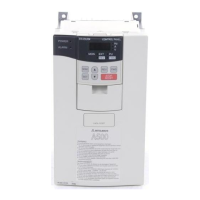
